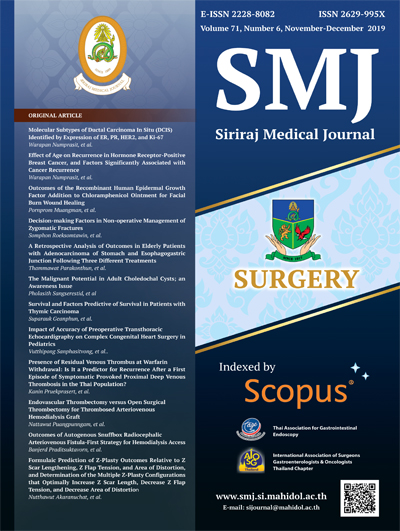Formulaic Prediction of Z-Plasty Outcomes Relative to Z Scar Lengthening, Z Flap Tension, and Area of Distortion, and Determination of the Multiple Z-Plasty Configurations that Optimally Increase Z Scar Length, Decrease Z Flap Tension, and Decrease Area of Distortion
DOI:
https://doi.org/10.33192/Smj.2019.75Keywords:
Mathematical prediction; Z-plasty outcomes; Z scar lengthening; Z flap tension; area of distortion; multiple Z-plasty configurationsAbstract
Objective: To generate mathematical formulas to predict Z-plasty outcomes relative to Z scar lengthening, Z flap tension, and area of distortion, and to determine the multiple Z-plasty configurations that optimally increase Z scar length, decrease Z flap tension, and decrease area of distortion.
Methods: Each Z-plasty configuration was evaluated for highest percent Z scar lengthening, lowest tension to close Z flap, and lowest area of distortion. For part 1 of the study, conventional one-flap, two-flap, four-flap, and eight-flap Z-plasties were created, after which relocation of the Z flaps was performed. The outcomes were analyzed and formulas were generated to predict Z-plasty outcomes. In part 2, the following modifications to the four-flap Z-plasty were made: modification of Z flap angle, modification of Z flap limb size, and addition of a gap between each Z flap. Outcomes were evaluated to identify the configuration that produced the optimal outcome for each outcome measure.
Results: Thirty-six pig skins were incised and sutured under controlled condition. For part 1, one-flap Z-plasty was best for Z scar lengthening, and 8-flap Z-plasty was best for reducing both tension to close and area of distortion. Three formulas were generated to predict the studied outcomes of Z-plasty. For part 2, the configuration that added a gap of 75% of the central limb length yielded the best outcome for scar length and also work very well for reducing the tension to close. The conventional design was the best for minimizing area of distortion.
Conclusion: Mathematical formulas were generated to predict Z scar percent lengthening, Z flap tension to close, and area of distortion. Addition of a gap 75% of the central limb length was the most efficacious Z-plasty configuration for increasing Z scar length.
Downloads
Published
How to Cite
Issue
Section
License
Authors who publish with this journal agree to the following conditions:
Copyright Transfer
In submitting a manuscript, the authors acknowledge that the work will become the copyrighted property of Siriraj Medical Journal upon publication.
License
Articles are licensed under a Creative Commons Attribution-NonCommercial-NoDerivatives 4.0 International License (CC BY-NC-ND 4.0). This license allows for the sharing of the work for non-commercial purposes with proper attribution to the authors and the journal. However, it does not permit modifications or the creation of derivative works.
Sharing and Access
Authors are encouraged to share their article on their personal or institutional websites and through other non-commercial platforms. Doing so can increase readership and citations.















